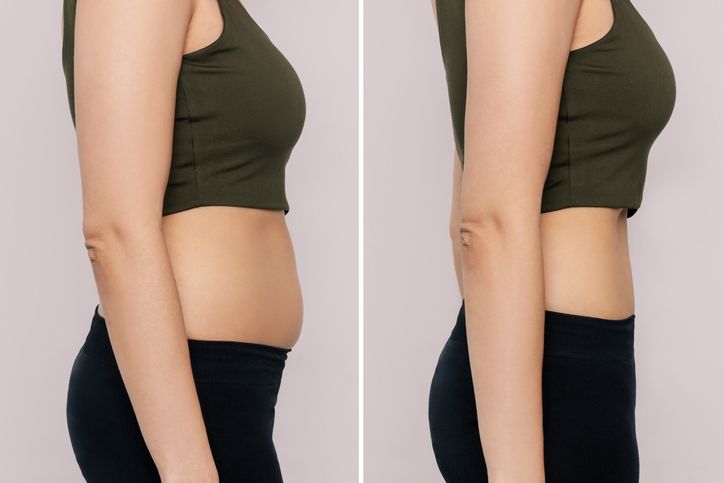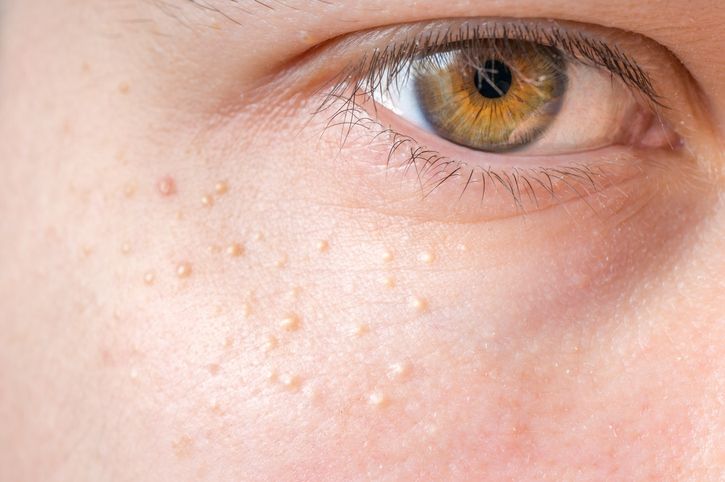- Home
- Trend
- Weight Loss Strategies
- Acne Tips
- Hair Health Information
- Blemish Removal Tips
- Acne Scar Removal Tips
- Muscle Building Techniques
- Intimate Care Tips
- Postpartum Intimate Care
- Eye Bags Wiki
- Tips for Face Slimming
- Secret of Permanent Hair Removal
- Breast Enlargement Tips
- Cure to Snoring
- Marionette Lines
- Skin-Tightening Secrets

免費體驗
S6 Body Sculpting Treatment
1 Minute Self-Registration
Date should not be before minimal date
A flat and toned stomach is a fitness goal many people aspire to achieve. However, it requires a combination of targeted exercises, mindful dietary choices, and lifestyle adjustments to make a noticeable difference. In this comprehensive guide, we'll explore 10 effective ways to transform your midsection and attain the flat stomach you desire.
1
Fat & Flat Stomach: Why Some People Get a Flat Stomach and Some Don't?

Not everyone has a flat stomach, and there are several reasons for this:
1. Genetics
Genetics play a significant role in determining how your body stores fat. Some people naturally store fat in their abdominal area, making it harder to achieve a flat stomach.
2. Body fat percentage
Your overall body fat percentage affects the appearance of your stomach. If you have a higher percentage of body fat, it can lead to a rounder or less flat stomach.
3. Diet and nutrition
Poor eating habits and a diet high in processed foods, unhealthy fats and regular sugar sweetened beverage consumption can lead to weight gain and a less flat stomach. A diet rich in fruits, vegetables, lean proteins, and whole grains can help maintain a flatter stomach.
4. Lack of exercise
A sedentary lifestyle can lead to weight gain and a less toned abdomen. Regular exercise, particularly core-strengthening exercises, can help tone the abdominal muscles and reduce belly fat.
5. Age
As people age, their metabolism tends to slow down, and they may lose muscle mass. This can result in a shift in body composition, with more fat accumulating in the abdominal area.
6. Hormonal changes
Hormonal changes, such as those that occur during pregnancy or menopause, can influence the distribution of fat in the body, often leading to a less flat stomach.
7. Bloating
Temporary bloating can make the stomach appear less flat. This can be caused by factors like eating gas-producing foods, constipation, or digestive issues.
8. Medical conditions
Certain medical conditions, such as irritable bowel syndrome (IBS), celiac disease, or polycystic ovary syndrome (PCOS), can contribute to abdominal bloating or weight gain.
2
How Do I Measure If I Have Excess Abdominal Fat?

You can measure whether you have a fat stomach or a flat stomach using several methods. Here are some common ways to assess your stomach's composition:
Body Mass Index (BMI)
BMI is a simple calculation based on your height and weight. While it doesn't specifically measure stomach fat, it can give you a rough estimate of whether you fall into a healthy weight range. However, it doesn't account for muscle mass, so it may not be the most accurate indicator for everyone.
Waist circumference
Measuring your waist circumference is a more specific way to assess abdominal fat. To do this, use a tape measure and wrap it around your waist, just above your hipbones. A waist circumference of more than 35 inches (88 cm) for women and 40 inches (102 cm) for men is often associated with increased health risks due to abdominal fat.
Body fat percentage
Measuring your body fat percentage is one of the most accurate methods for assessing stomach fat. This can be done using specialised scales, body composition analyzers, or with the assistance of a fitness professional. A healthy body fat percentage varies by age and gender but generally falls between 15% and 25% for adults.
Visual assessment
You can also visually assess whether you have a flat stomach or not. Stand in front of a mirror and look at your abdominal area. If your stomach appears toned and relatively flat, you likely have less abdominal fat. If you notice a protruding belly or excess fat around the midsection, you may have more abdominal fat.
Clothing fit
How your clothes fit can also be a practical indicator. If your pants or skirts feel tight around the waist, it could be a sign of excess abdominal fat.
Skinfold measurements
A skinfold calliper can be used to measure the thickness of subcutaneous fat (fat under the skin) at specific sites on the body, including the abdomen. This method is often used by fitness professionals to estimate body fat percentage.
DEXA Scan or MRI
For the most accurate measurement of body fat and abdominal fat distribution, you can undergo a DEXA scan or MRI. These are medical imaging techniques that provide detailed information about body composition.
- How To Fix Postpartum Diastasis Recti: 4 Major Causes + 5 Core-Strengthening Tips
- Post-Meal Walking Beats Standing — Follow These 3 Golden Rules!
- [2025 Hong Kong Beauty Salon Guide] 6 Common Scams to Avoid + Most Popular Facial & Slimming Treatments!
- Stretching For Weight Loss: 15 Must-Do Stretches For A Toned Body
3
What Food Can Increase Your Tummy's Shape and Increase Total Body Fat?

If you're looking to maintain a flat stomach or lose abdominal fat, it's essential to be mindful of your diet. While individual responses to foods can vary, here are five types of foods that, when consumed in excess or as part of an unhealthy diet, can contribute to weight gain or a less flat stomach:
1. Sugary foods and beverages
Foods and drinks high in added sugars can lead to weight gain and belly fat. This includes sugary sodas, candy, pastries, and many processed foods. Consuming too much sugar can increase insulin levels, promoting fat storage in the abdominal area.
2. Processed and fast foods
Highly processed foods often contain unhealthy trans fats, refined carbohydrates, and excessive salt. These foods are calorie-dense and can lead to weight gain, particularly around the midsection. Fast food items like burgers, fries, and sugary drinks are examples.
3. Fried foods
Fried foods are often high in unhealthy trans fats and calories. Excessive consumption of fried foods, such as fried chicken, french fries, and donuts, can contribute to weight gain and abdominal fat.
4. Alcohol
Alcohol is calorie-dense and can contribute to weight gain, especially when consumed in excess. It can also impair judgement, leading to poor food choices. Some alcoholic drinks, like sugary cocktails, can be particularly high in calories.
5. Excessive carb-heavy foods
Consuming large quantities of refined carbohydrates, such as white bread, white rice, and sugary cereals, can lead to spikes in blood sugar levels and increased fat storage, including abdominal fat.
It's important to note that it's not necessarily the individual foods themselves but rather their quantity and overall dietary context that can lead to weight gain and a less flat stomach. In moderation, many of these foods can be enjoyed as part of a balanced diet.
4
10 Ways to Lose Belly Fat That Comes with Health Benefits

To maintain a flat stomach or work toward losing abdominal fat, focus on:
1. Whole foods
When we talk about incorporating whole, unprocessed foods, we're emphasising the importance of nourishing your body with natural, nutrient-dense choices. Fruits and vegetables provide essential vitamins, minerals, and fibre that support overall health and digestion. Lean proteins, like chicken or tofu, aid in muscle repair and growth. Whole grains, such as brown rice and quinoa, offer sustained energy and help you feel full longer. Healthy fats from sources like avocados and nuts are crucial for various bodily functions, including hormone production and brain health.
2. Portion control
Even when consuming nutritious foods, portion control plays a significant role in weight management. It's easy to overeat, even healthy foods, if portion sizes are too large. Being mindful of portion sizes helps you regulate calorie intake and prevents excess energy from being stored as fat. Consider using smaller plates, measuring portions, and paying attention to hunger cues to avoid overindulging.
3. Balanced diet
A balanced diet ensures that you receive a wide range of essential nutrients your body needs to function optimally. It's not just about calories; it's about getting the right mix of carbohydrates, proteins, and fats, along with vitamins and minerals. A diverse diet supports everything from energy production to immune function. Reducing calorie intake is often necessary for weight loss, but it should be done in a way that maintains this balance.
4. Regular exercise
Physical activity is a key component of a healthy lifestyle. Engage in core strengthening workouts. Cardiovascular exercises like running or cycling help burn calories and improve heart health, while strength training exercises build muscle, increasing your metabolic rate. The combination of both is particularly effective for fat loss because it helps create a calorie deficit while preserving lean muscle mass. Muscle tissue requires more energy, even at rest, so having more muscle can help you burn more calories. Also, specific area exercises can help strengthen the core muscles, thus it's essential for achieving a flat stomach. Incorporate planks, crunches, leg raises, and Russian twists into your routine to strengthen and tone your abdominal muscles.
5. Hydration
Staying well-hydrated is essential for many bodily functions, including digestion and metabolism. Drinking plenty of water helps control appetite and can prevent overeating. Substituting sugary and calorie-laden beverages with water is an easy way to reduce calorie intake and promote a healthy weight.
6. Stress management
High stress levels can lead to the release of cortisol, a hormone associated with increased abdominal fat. Stress-reduction techniques like meditation, yoga, or deep breathing can help lower stress levels, potentially preventing weight gain or aiding in weight loss. Stress management also contributes to better overall mental and emotional well-being.
7. Consistent sleep patterns
Establishing a regular sleep routine is vital for weight management. Poor sleep can disrupt hunger hormones, leading to increased cravings for high-calorie, sugary foods. Aim for 7-9 hours of quality sleep per night to support a healthy metabolism and reduce the likelihood of weight gain.
8. Mindful eating
Practising mindful eating involves paying close attention to what you eat, savouring each bite, and listening to your body's hunger and fullness cues. This approach can help you avoid emotional or stress-related eating, reduce overeating, and make healthier food choices overall.
9. Social support and accountability
This is pretty important as many would find it hard to commit to their new habit as they don't share the joy of shedding body fat with someone they know. Sharing your health and fitness goals with a friend, family member, or a support group can provide motivation and accountability. When you have others cheering you on, it can be easier to stick to your diet and exercise plans. Consider joining a fitness class, participating in group challenges, or seeking out a workout buddy to stay on track.
Incorporating these strategies into your lifestyle can lead to better health and help you achieve your fitness goals. However, individual responses to diet and exercise can vary, so it's advisable to seek personalised guidance from healthcare professionals or registered dietitians who can tailor recommendations to your specific needs and monitor your progress effectively.

免費體驗
S6 Body Sculpting Treatment
1 Minute Self-Registration
Date should not be before minimal date
5
The 10th Way: Reducing Belly Fat in Style and Comfort with Perfect Medical

Notice the 10th way has been missing? You're right. Here's the last resort for you to get a flat stomach without the need of torturing your digestive system or hit the gym for a high intensity interval training. Introducing the S6 Body Sculpting Treatment - your ultimate body transformation secret! While adopting a vegetarian diet can be a helpful step towards shedding pounds, we've got a revolutionary solution that promises quick, effective weight loss. Say goodbye to excess fat in a flash!
Our cutting-edge S6 Body Sculpting Treatment harnesses the power of advanced bio-laser technology, going deep into those stubborn fat layers. It doesn't just melt away the fat; it zaps it! Your body's trusty allies, the lymphatic system and metabolic processes, then work together to bid that unwanted fat farewell.
But that's not all – imagine having the power to reshape specific trouble spots. Feel a bit self-conscious about those flabby underarms? With the S6 Body Sculpting Treatment, you can sculpt and contour without resorting to risky surgeries or those dreaded injections.
Here's the real game-changer: our skilled estheticians can precisely target and reduce fat only where you need it. Our cutting-edge device emits that magical bio-laser, penetrating deep beneath your skin to tackle those pesky fat deposits. Once the fat is dissolved, your metabolism kicks into high gear, flushing out those unwanted inches. Brace yourself for instant results, getting you one step closer to the body you've always dreamed of – all in just a single treatment session!
Ready to unveil a new you? The S6 Body Sculpting Treatment is here to help you achieve your desired body composition like never before. Say hello to a sculpted, confident you!

免費體驗
S6 Body Sculpting Treatment
1 Minute Self-Registration
Date should not be before minimal date
FAQ

1. How long does it take to achieve a flat stomach?
Achieving a flat stomach varies from person to person due to factors like genetics, diet, exercise, and metabolism. However, with consistent effort, you can typically start seeing noticeable changes within a few weeks to a few months. Some individuals might see results even faster, especially if they incorporate effective treatments or interventions designed for fat loss.
2. Can spot reduction exercises eliminate excess body fat?
Spot reduction, the idea that you can lose fat in a specific area of your body through targeted exercises, is a common misconception. While targeted exercises can strengthen and tone the muscles in a particular area, they don't directly eliminate fat from that area. Fat loss is a systemic process, and when you lose weight or body fat, it occurs proportionally across your entire body.
3. Does excess water weight contribute to a bigger tummy?
While some fluctuations in water weight can lead to temporary bloating or changes in stomach size, they are generally not a significant contributor to a permanently bigger tummy. Factors like sodium intake, hormonal changes, and dehydration can cause water retention and bloating. However, these effects are usually temporary and can be managed through dietary adjustments and proper hydration.
4. Can I achieve a flat stomach without exercise?
Achieving and maintaining a flat stomach is best accomplished through a combination of a healthy diet and regular exercise. While dietary changes can contribute to fat loss, exercise is crucial for various reasons. It not only burns calories but also strengthens the abdominal muscles, helping to improve their appearance. Furthermore, exercise provides numerous overall health benefits beyond just aesthetic improvements.
5. Is it normal to have some belly fat?
Yes, it is entirely normal and even healthy to have some amount of belly fat. Fat serves as an essential energy reserve and plays a role in protecting internal organs. The goal should not be to eliminate all belly fat but to maintain a healthy body composition. Striving for extreme leanness can be unrealistic and may not necessarily equate to better health.








